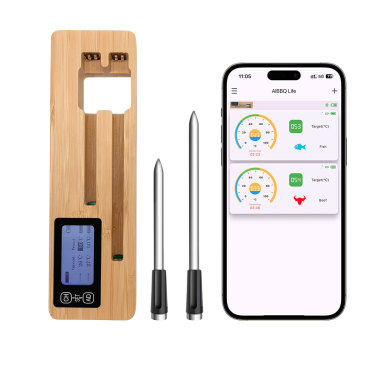Digital Meat Thermometer: The Essential Tool for Perfect Cooking

# Digital Meat Thermometer: The Essential Tool for Perfect Cooking
## Why Every Home Chef Needs a Digital Meat Thermometer
Cooking meat to perfection is both an art and a science. While experience plays a significant role, even the most seasoned chefs rely on precise temperature measurements to ensure food safety and optimal flavor. This is where a digital meat thermometer becomes indispensable in any kitchen.
Unlike traditional analog thermometers, digital versions provide instant, accurate readings that take the guesswork out of cooking. Whether you’re grilling steaks, roasting a turkey, or smoking brisket, this simple tool can mean the difference between a culinary masterpiece and a disappointing meal.
## Key Features to Look for in a Digital Meat Thermometer
When shopping for a digital meat thermometer, consider these essential features:
– Fast and accurate readings (typically within 2-3 seconds)
– Wide temperature range (from freezing to well-done temperatures)
– Waterproof design for easy cleaning
– Backlit display for visibility in low-light conditions
– Long probe for safe measurement in deep cuts of meat
– Magnetic or clip-on design for convenient storage
Some advanced models even offer wireless connectivity, allowing you to monitor temperatures remotely via smartphone apps – perfect for slow-cooked meals.
## How to Use Your Digital Meat Thermometer Effectively
Keyword: digital meat thermometer
Proper technique is crucial for getting accurate readings:
1. Insert the probe into the thickest part of the meat, avoiding bones and fat
2. For poultry, check both the breast and thigh areas
3. Wait for the temperature to stabilize (usually just a few seconds)
4. Clean the probe immediately after use to prevent cross-contamination
Remember that meat continues to cook after removal from heat (carryover cooking), so many chefs recommend removing meat 5-10°F below the target temperature.
## Temperature Guidelines for Perfect Results
Here are the USDA-recommended safe minimum internal temperatures:
– Poultry (chicken, turkey): 165°F (74°C)
– Ground meats: 160°F (71°C)
– Pork, lamb, veal, beef (steaks, roasts): 145°F (63°C) with 3-minute rest
– Fish: 145°F (63°C)
For premium steaks, many chefs prefer these temperatures for optimal doneness:
– Rare: 120-125°F (49-52°C)
– Medium rare: 130-135°F (54-57°C)
– Medium: 140-145°F (60-63°C)
– Medium well: 150-155°F (66-68°C)
– Well done: 160°F+ (71°C+)
## Maintaining Your Digital Meat Thermometer
To ensure long-term accuracy and performance:
– Calibrate your thermometer periodically (many models include calibration instructions)
– Store in a protective case to prevent damage to the probe
– Replace batteries as needed (low battery can affect accuracy)
– Avoid exposing to extreme temperatures when not in use
– Never submerge the display unit in water unless specifically designed for it
## The Bottom Line
Investing in a quality digital meat thermometer is one of the smartest decisions a home cook can make. Not only does it help prevent foodborne illness by ensuring proper cooking temperatures, but it also takes the stress out of preparing meats to perfect doneness. From weeknight dinners to holiday feasts, this simple tool will quickly become your most trusted kitchen companion.